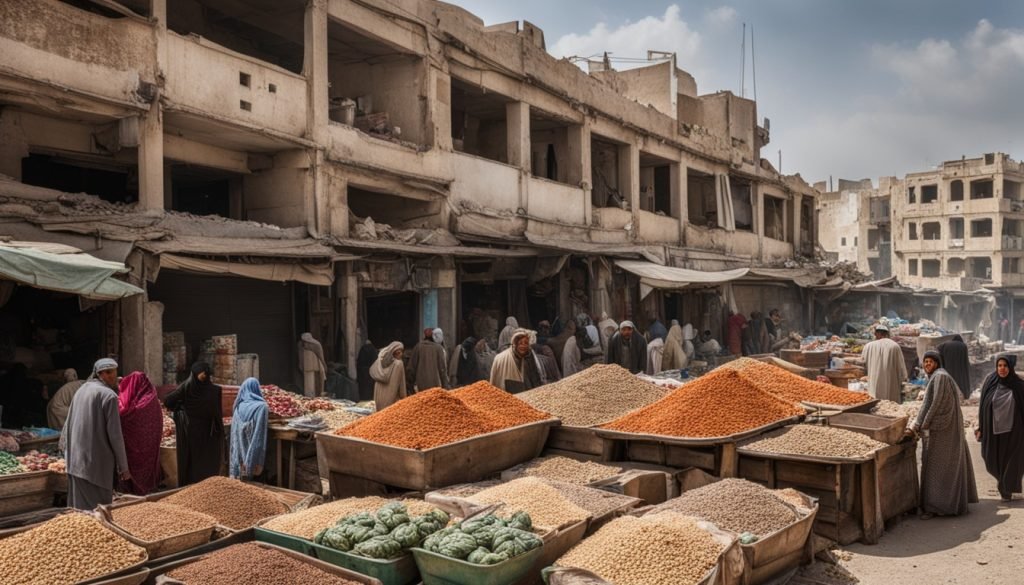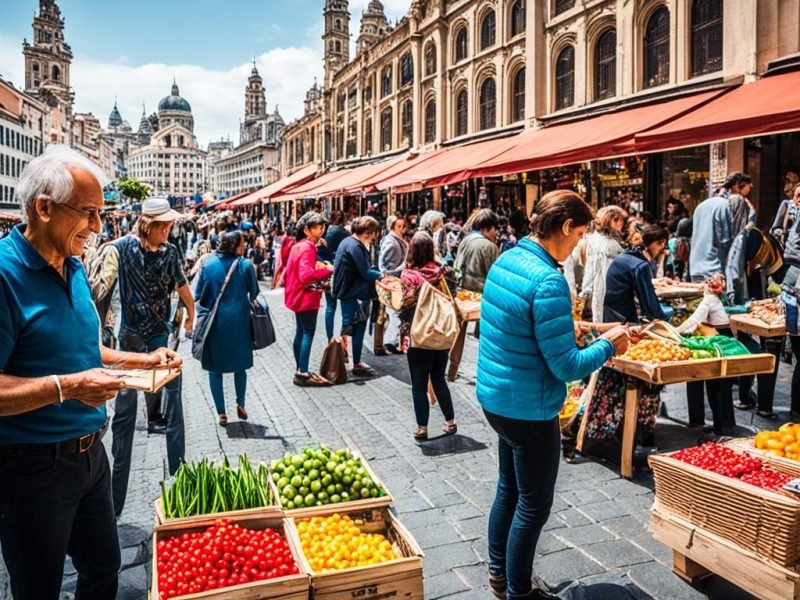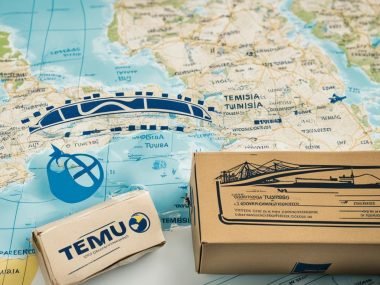Is it fair to say Tunisia is poor? Let’s explore its wealth. We’ll look at Tunisia’s economy, poverty rates, and its GDP.
Tunisia’s place in the global economy becomes clear as we dig deeper. Factors like GDP per capita and purchasing power matter. Tunisia’s past also affects its economy. This includes political woes, colonial history, corruption, and disasters.
The COVID-19 pandemic made poverty worse globally. It pushed many back into extreme poverty. The poverty line is now $2.15 a day. This situation has also hit Tunisia hard.
Key Takeaways
- Tunisia’s economic development is influenced by historical and political factors.
- Poverty rates in Tunisia reflect larger global economic challenges.
- The COVID-19 pandemic exacerbated economic vulnerabilities worldwide, impacting Tunisia significantly.
- GDP per capita and PPP are critical indicators of economic health.
- Understanding Tunisia’s economic landscape requires analysing both historical and contemporary contexts.
Overview of Tunisia’s Economy
Tunisia’s economy has changed a lot over time. To understand it, we look at the past, main jobs, and new growth areas.
Historical Economic Trends
In the 1970s, Tunisia’s economy grew fast, especially the GDP per person. But, it faced problems in the mid-1980s. Changes were made to fix these issues.
These changes helped modernise and diversify the economy.
Main Industries
Key jobs like tourism, textiles, and farming drive Tunisia’s economy now. Tourism brings in many visitors each year. The textile sector is big for exports.
Farming is important too. It creates jobs and adds to the country’s wealth.
Recent Economic Developments
In recent times, Tunisia has started many projects to grow the economy. A big plan supports small and medium businesses. This helps them be strong and creative.
The country is also working on renewable energy. This will make it more green and less reliant on outside energy. They’ve also started a sanitation project with private companies. It will make public health and facilities better.
| Sector | Key Contributions |
|---|---|
| Tourism | Major source of revenue and employment |
| Textiles | Significant export sector |
| Agriculture | Vital for employment and GDP |
| Renewable Energy | Initiatives to enhance sustainability |
| SMEs Support | Frameworks to foster resilience and innovation |
GDP and Economic Growth in Tunisia
Understanding Tunisia’s GDP and growth patterns is important. It tells us about the country’s economic health. We compare it with the world to see where Tunisia stands.
GDP Statistics
Looking at Tunisian GDP stats, we see moderate growth despite challenges. The GDP shows the value of all goods and services made in Tunisia. Here are some key figures:
| Year | Total GDP (in USD Billion) | GDP Growth Rate (%) |
|---|---|---|
| 2018 | 39.20 | 2.6 |
| 2019 | 39.95 | 2.8 |
| 2020 | 38.40 | -8.9 |
| 2021 | 40.10 | 3.0 |
These numbers show us Tunisia’s economic path. We see times of steadiness and change.
Growth Trends
The Tunisian economy has grown and shrunk over time. Changes were due to many things, like politics and world markets. Before Covid, Tunisia’s economy was growing steadily. Then, the pandemic shook things up.
Comparative Analysis
To fully understand Tunisia’s GDP, we compare it with others. Benchmarking shows us how Tunisia does next to other places. This tells us about Tunisia’s progress and what needs work. It helps Tunisia get closer to world economic standards.
Poverty Rates in Tunisia
Poverty in Tunisia has grown into a big problem. It affects city and countryside areas. The COVID-19 pandemic has made it worse, even though some progress was made.
Current Statistics
Poverty rates in Tunisia change due to the economy and society. Official numbers show about 15.2% of people are poor. This varies in different places and among different people.
Urban vs Rural Poverty
There’s a big gap between city and countryside poverty in Tunisia. About 10.1% of city dwellers are poor. But in the countryside, that number jumps to 26.0%. This shows we need special plans for rural areas to help everyone equally.
Impact of COVID-19
COVID-19 hit Tunisia’s economy hard. It led to more people losing jobs and earning less. This problem affected both cities and the countryside. It pushed many families into poverty. Now, there’s a big need for plans to help the country recover.
| Region | Poverty Rate |
|---|---|
| Urban | 10.1% |
| Rural | 26.0% |
Tunisia’s Economic Challenges
Tunisia faces many economic problems. These issues are political unrest, high joblessness, and growing wealth gaps. Each one hurts the nation’s economy in different ways.
Political Instability
Tunisia has had a rocky political scene for a while. This chaos affects its economic health. Government changes and fights stop stable economic growth. This scares off investors, making things worse.
Unemployment Rates
Many people in Tunisia can’t find jobs. This big problem stays, despite efforts to fix it. It’s tough for young people and graduates. This job crisis leads to unhappiness and unrest.
Income Inequality
Tunisia has big wealth gaps among its people. This problem is seen everywhere, in cities and the countryside. Fair policies to share wealth equally are needed. They should help everyone, no matter where.

Tunisia’s fight against these troubles is tough. It needs to fix political issues, lower unemployment, and share wealth better. Everyone needs to work together for a hopeful future.
Living Standards in Tunisia
Tunisia is a country in North Africa. It has a rich history and modern living. To understand living standards there, we must look at what life is like for its people.
Cost of Living
The cost of living changes a lot by location. Cities like Tunis, Sfax, and Sousse cost more. Things like food, utility bills, and getting around are cheaper. But, economic differences affect many families.
Housing and Infrastructure
Housing tells us a lot about living standards. In cities, there are modern apartments. But in rural areas, homes are more traditional. Cities are improving roads and services. Yet, the countryside is still behind.
Access to Services
Services like schools and hospitals matter too. Cities have many schools and learning is a must for kids. Health services are there but could be better. Work is being done to help everyone get these services.
| Aspect | Urban Areas | Rural Areas |
|---|---|---|
| Cost of Living | High | Low |
| Tunisian Housing Quality | Modern | Traditional |
| Public Services Access | Widespread | Limited |
Employment and Unemployment in Tunisia
Tunisia’s job scene is complex, shaped by many factors. Looking at job stats, key sectors, and government moves helps us understand it. This lets us see what’s happening now and what might happen for workers in Tunisia.
Employment Statistics
Tunisia’s job stats show us how work life changes there. The job rate changes with economic ups and downs. Knowing these stats highlights important areas to work on.
| Year | Employment Rate (%) | Unemployment Rate (%) |
|---|---|---|
| 2018 | 44.2 | 15.5 |
| 2019 | 44.6 | 15.3 |
| 2020 | 42.1 | 16.9 |
The table shows job and no-job rates recently. It shows how tough times and COVID-19 changed jobs in Tunisia.
Major Employment Sectors
Knowing the big job sectors helps us get Tunisia’s economy. Main areas are farming, clothes making, tourism, and tech. These areas grow the economy and create many jobs.
- Agriculture: 15% of the workforce
- Textiles: 20% of the workforce
- Tourism: 18% of the workforce
- Information Technology: 10% of the workforce
These percentages show how various sectors chip in to jobs. It shows the different ways people work in Tunisia.
Government Initiatives
The government is tackling joblessness and trying to make more jobs. They’re doing things like training, changing the economy, and drawing in foreign money.
There’s the National Employment Fund too. It helps those looking for work and backs starting businesses. Also, there’s money put into building projects that get people working and help the economy.
All these actions aim to make jobs better in Tunisia. They work on skills, spur on new ideas, and make a good space for business.
Social Welfare Programmes
Tunisia’s social welfare programmes show how the country cares for its people. They help those who are vulnerable and need support. This makes sure no one is left without help.
Overview of Social Welfare
Tunisia offers many services to help those in tough situations. They provide healthcare aid, money for school, and support for families with low income. This helps to maintain the dignity and well-being of its citizens.
Effectiveness and Reach
The success of Tunisia’s welfare programmes is important. Reviews show they have reached many in need, but there are still hurdles. To do better, the programmes must keep changing and improve.
Impact on Poverty Alleviation
The welfare programmes in Tunisia have greatly reduced poverty. They’ve made society more inclusive by narrowing the wealth gap. Continually improving these programmes is key for a stable and prosperous Tunisia.
Income Inequality in Tunisia
Income inequality in Tunisia is a big concern. It shows in the economic gaps among people. Understanding this helps us see how deep and wide these gaps are.

Current Status
The gap between rich and poor in Tunisia is large. Wealth mainly stays in cities like Tunis. Rural areas, however, have fewer resources and chances.
This gap makes life hard for many. It also slows down social bonding and progress.
Government Efforts to Address Inequality
The government is trying to fix this inequality. It has started many programmes. These include welfare, tax reforms, and developing poor areas.
These efforts aim to give everyone the same chance at education, health, and work.
Long-term Implications
Without action, the gap in Tunisia could worsen. It could lead to lasting poverty cycles. This might cause more social unrest and pressure the country.
It’s important to tackle these issues with sustainable plans. This will help Tunisia grow economically and socially.
| Indicator | Urban | Rural |
|---|---|---|
| Average Income | $18,000 | $9,000 |
| Access to Education | 85% | 62% |
| Healthcare Access | 78% | 53% |
Rural-Urban Divide in Tunisia
Tunisia has clear differences between its rural and urban areas. These differences are seen in jobs and access to services like schools and hospitals. It’s important to understand these issues to improve life across the country.
Economic Opportunities
City and countryside jobs in Tunisia are very different. Cities like Tunis offer more and better-paid jobs than in the countryside. This makes many people leave rural areas to find work in cities.
In contrast, jobs in rural areas are fewer, often in farming. This lack of jobs causes unemployment to rise. It’s why many seek opportunities in urban settings.
Access to Education and Healthcare
Education and healthcare vary greatly between countryside and cities in Tunisia. Cities have more schools and universities, meaning better education. However, rural areas often have fewer schools that might not offer as good an education.
Similarly, cities have more hospitals and clinics than rural areas. This means people in cities get better healthcare. Those living in the countryside may not have easy access to medical services.
Infrastructure Disparities
Cities in Tunisia enjoy good roads, public transport, and reliable services. This is not the case for the countryside. Poor infrastructure like roads and limited transport options can make life hard in rural Tunisia.
| Aspect | Urban Areas | Rural Areas |
|---|---|---|
| Economic Opportunities | Higher wages, more job options | Lower wages, fewer jobs |
| Education | Better quality, more institutions | Limited availability, lower standards |
| Healthcare Access | Better services, more facilities | Inadequate infrastructure, fewer services |
| Infrastructure | Developed, reliable utilities | Underdeveloped, unreliable utilities |
Is Tunisia A Poor Country?
Tunisia has faced some tough economic times. But how does it stand next to other countries? We need to look at this from many sides.
Comparison with Other Nations
Tunisia’s economy is a bit of a mix compared to others. It does better than many countries in sub-Saharan Africa. This is when we look at GDP per person.
But against Europe’s giants or growing Asia, Tunisia is behind. Political troubles and economic shocks have slowed growth.
Tunisia has a lot to offer but still trails behind neighbors like Morocco and Algeria. These countries have handled investments and policies better.
International Aid and Support
International support for Tunisia is very important. Groups and countries worldwide have given aid to help Tunisia’s economy. This includes help from the World Bank, IMF, and the European Union.
Much aid supports small businesses and green energy. These steps have helped but there’s still a long way to go.
Future Projections
Tunisia’s economy has a bright but challenging future. With reforms and good use of aid, growth is possible. Improving government openness and market participation is key.
Investing in renewable energy and tech could boost Tunisia’s economy. Keeping international support is crucial for success.
In the end, Tunisia’s economic future relies on reforms and ongoing aid. We’ll see if these efforts make Tunisia more prosperous.
World Bank and Tunisia’s Economic Development
The World Bank and Tunisia work together to help the country grow stronger economically. They use a plan called the Partnership Framework. It helps by picking important areas to help Tunisia grow better.
Partnership Framework
The Partnership Framework looks at different parts of growing the economy. These parts include things like building better roads, schools, and clean water systems. This plan works well with what Tunisia wants to achieve. It helps make the economy stable and helps everyone grow together. It also makes sure no one is left behind by focusing on sustainable growth and reducing poverty.
Key Projects and Investments
The World Bank has started lots of important projects in Tunisia. These projects help with things like green energy and making schools better. They also work on improving services for everyone. Projects that are worth noting include money for solar power and helping small businesses grow. These small businesses are very important for getting the economy back on its feet and creating jobs. Working on projects with both the public and private sectors has also made the cities and towns better places to live.
Outcome and Impact
The help from the World Bank has made a big difference in Tunisia. It has made many parts of the economy stronger and created new jobs. It has made life better for people. For example, more people can go to school and have electricity. All these things together mean Tunisia is moving forward in a good way. It shows how important it is for countries to work together and help each other.
| Sector | Key Investments | Impact |
|---|---|---|
| Renewable Energy | Solar Energy Plants | Improved Energy Access and Sustainability |
| Education | Upgrading Educational Facilities | Enhanced Learning Environments |
| Infrastructure | Public-Private Partnerships | Urban Development and Improved Public Services |
Conclusion
We have studied Tunisia’s economy and society closely. Now, we can share a detailed summary. Tunisia is growing but faces big problems like income inequality, joblessness, and shaky politics. These issues make life hard and keep many people poor.
In cities and the countryside, life is very different. This affects jobs, schools, and hospitals. The World Bank is helping with some projects. But more actions are needed to help those in the greatest need. Tunisia’s social aids have helped, but they must grow stronger and wider.
Tunisia is not simply a poor country. But, it does face economic pressures. With the right steps and help from the world, Tunisia can build a stronger economy. This will improve everyone’s life there. The road ahead is tough, but a brighter future is possible for Tunisia. This summary shows Tunisia’s situation today and the challenges it must meet.







